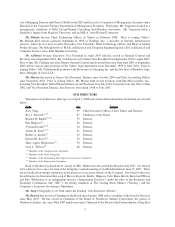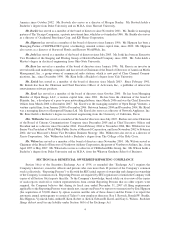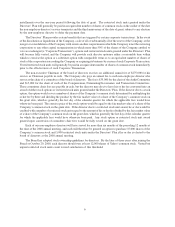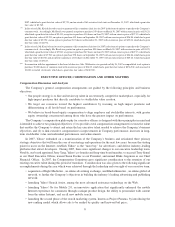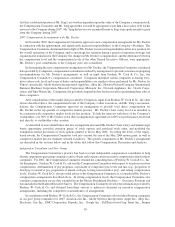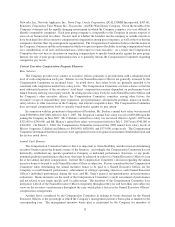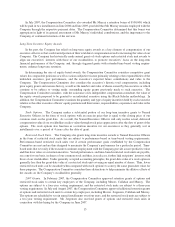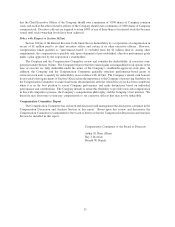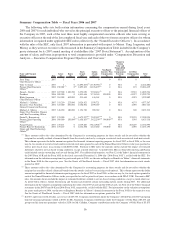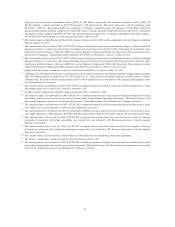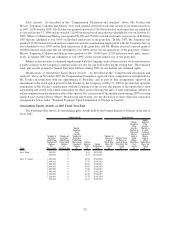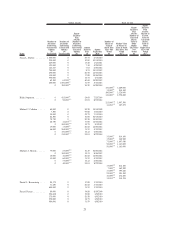Yahoo 2007 Annual Report Download - page 132
Download and view the complete annual report
Please find page 132 of the 2007 Yahoo annual report below. You can navigate through the pages in the report by either clicking on the pages listed below, or by using the keyword search tool below to find specific information within the annual report.In July 2007, the Compensation Committee also awarded Mr. Murray a retention bonus of $100,000, which
will be paid in two installments in June 2008 and June 2009, provided that Mr. Murray remains employed with the
Company through the respective payment dates. The Compensation Committee determined that this bonus was
appropriate in light of its general assessment of Mr. Murray’s individual contributions, and the importance to the
Company of continued retention of his services.
Long-Term Incentive Equity Awards
In the past, the Company has relied on long-term equity awards as a key element of compensation of our
executive officers so that a substantial portion of their total direct compensation is tied to increasing the value of our
Company. The Company has historically made annual grants of stock options and restricted stock unit awards to
align our executives’ interests with those of our stockholders, to promote executives’ focus on the long-term
financial performance of the Company, and, through staggered grants with extended time-based vesting require-
ments, enhance long-term retention.
In determining the size of equity-based awards, the Compensation Committee considers competitive grant
values for comparable positions as well as various subjective factors primarily relating to the responsibilities of the
individual executive, past performance, and the executive’s expected future contributions and value to the
Company. The Compensation Committee also considers the executive’s historic total compensation, including
prior equity grants and exercise history, as well as the number and value of shares owned by the executive or which
continue to be subject to vesting under outstanding equity grants previously made to such executive. The
Compensation Committee considers, with the assistance of its independent compensation consultant, the value of
the equity awards proposed to be granted to an individual executive using the Black-Scholes methodology. In
addition, the Compensation Committee examines the quantity and type of equity incentives held by each executive
relative to the other executive officers’ equity positions and their tenure, responsibilities, experience and value to the
Company.
Stock Options. The Company makes a substantial portion of our long-term incentive grants to Named
Executive Officers in the form of stock options with an exercise price that is equal to the closing price of our
common stock on the grant date. As a result, the Named Executive Officers will only realize actual, delivered
compensation value if our stockholders realize value through stock price appreciation after the date of grant of the
options. The stock options also function as a retention incentive for our executives as they generally vest in
installments over a period of 4 years after the date of grant.
Restricted Stock Units. The Company also grants long-term incentive awards to Named Executive Officers
in the form of restricted stock units that are subject to performance-based or time-based vesting requirements.
Performance-based restricted stock units vest if certain performance goals established by the Compensation
Committee are met and are thus designed to maximize the Company’s performance for a particular period. Time-
based units that vest only if the executive continues employment with the Company provide a more predictive value
and thus have value as a retention incentive. Vested performance- and time-based restricted stock units are payable,
on a one-for-one basis, in shares of our common stock and thus, in each case, further link recipients’ interests with
those of our stockholders. Under generally accepted accounting principles, the grant-date value of a stock option is
generally less than the grant-date value of a restricted stock unit covering an equal number of shares. Thus, fewer
restricted stock units can be awarded (when compared with stock options) to convey the same grant-date value for
these purposes. The Compensation Committee considers these distinctions to help minimize the dilutive effects of
the awards on the Company’s stockholders generally.
2007 Grants. In February 2007, the Compensation Committee approved retention grants of options and
restricted stock units to certain key employees of the Company, including Messrs. Callahan and Murray. The
options are subject to a four-year vesting requirement, and the restricted stock units are subject to a three-year
vesting requirement. In July and August 2007, the Compensation Committee approved additional retention grants
of options and restricted stock units to certain key employees, including Messrs. Jorgensen, Callahan and Murray.
The options are scheduled to vest in annual installments over four years, and the restricted stock units are subject to
a two-year vesting requirement. Mr. Jorgensen also received grants of options and restricted stock units in
connection with his hiring by the Company in June 2007.
13


